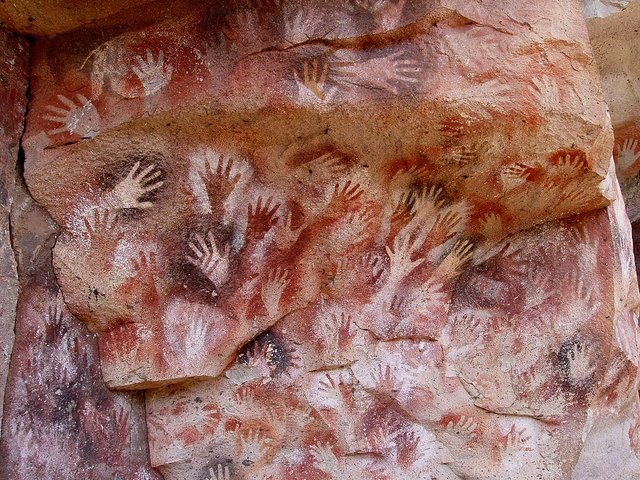First American paintings.
Primitive man, both in the Old World and in the American continent, began by painting human and zoomorphic figures, which had a magical character, on the rocks of the caves. The findings of Paleolithic American rock art are concentrated in four foci: Baja California, Brazil, Central Andes and Patagonia. This last area is of great importance: we have been able to differentiate seven styles in the hundreds of examples that have reached us. The oldest is the one that corresponds to the paintings of hands or feet, style very widespread in Patagonia, but far from exclusive in this region. The Cave of the Hands, dating from 7300 BC, is the best example.

The caves of Brazil.
The rock art of Brazil continues to awaken unknowns among researchers, both when it comes to classifying it thematically and when trying to determine its chronology. Of this set of findings, very abundant at present, stand out the Paraná caves and those of the Lagoa-Santa region (Minas Gerais state), where there are many animal figures represented in hunting scenes. On the other hand, in the Park of Seven Cities (north of Piauí) the abstract motifs predominate.

The Olmec art.
Of all the arts, the Olmecs - the first of the great civilizations that settled in ancient Mexico - especially cultivated sculpture. Its most notable artistic manifestations are the so-called colossal heads, sculptures of gigantic proportions - up to three meters high and ten tons in weight - made of stone. Their realism, delicacy and expressive force still make a profound impression in our days. Along with them stand out the seated figures, who adopt the attitude of an Egyptian scribe or who have on their lap a divinized child, like the stone sculpture The Lord of the Files.

The relief: altars and stelae.
A field in the Olmec sculptural art of enormous wealth and variety is that of the reliefs, which are developed in two types of monuments: altars and stelae. The altars are large blocks of stone with a prismatic shape, whose sides host scenes in high and bas-relief. Many more are the stelae, stone tombstones where characters appear with ornaments and very complicated dresses, usually represented in profile in scenes of difficult interpretation.

Chavín art.
Without forgetting its ceramics, the Chavín Andean civilization (1500-500 a.C.) shows its most finished products in sculpture and relief in stone or other materials. It is generally about linear works: smooth surfaces of stones in which incised drawings have been drawn, more or less regular volumes treated in the same way, or small pieces of bone or shell stones. Most of them are subordinated to architecture, especially in the sanctuary of Chavin de Huantar (Peru), north of the Peruvian Andes. Sculptures of round shape or works in which modeling is the main technique are very scarce.

Main sculptural works.
The main sculptural works of Chavín art have been found in the Templo Antiguo, of Chavín de Huantar. Among them are the Great Image, known as El lanzón; the Tello Obelisk; the Raimondi Stela; the eagle and the falcon of the Black and White Cover of the Great Pyramid, as well as many other pieces distributed throughout the ceremonial center. The images, recorded on flat surfaces, are closely related to the cult.

Teotihuacán and Monte Albán.
During the classic period (200 BC-900), two great artistic styles developed around the sacred cities of Teotihuacán and Monte Albán in the central Mexico area. The first is dominated by two huge stepped pyramids made of adobe and covered with sculpted stone. Teotihuacan art is subordinated to architecture, in which sculptures, reliefs and paintings are harmoniously integrated. For their part, the Zapotecs raised the valley of Oaxaca, the city of Monte Albán, where the beautiful necropolis surrounding the ceremonial center stands out. In her they have found impressive funeral urns and beautiful murals that decorate the tombs.

The sacred city.
Toetihuacán is a prodigy of urban design and architectural construction whose structure was widely imitated throughout the central Mexico area. The great avenue of the road of the Dead, with the pyramids of the Sun and the Moon, constituted the main axis, around which palatial and templarian constructions were raised, while the residential zones were located in all the neighborhoods of the outskirts. As for the Teotihuacan sculpture, the masks of the funerary rites and the reliefs that were used to decorate the walls of the main buildings stand out.

Superb blog, Thanks for these informations. Following!
Downvoting a post can decrease pending rewards and make it less visible. Common reasons:
Submit
Follow me.
Downvoting a post can decrease pending rewards and make it less visible. Common reasons:
Submit